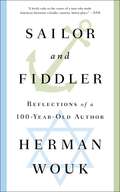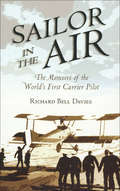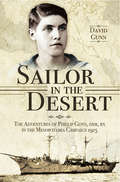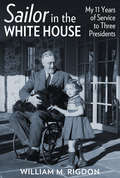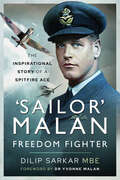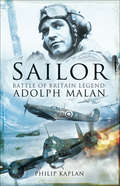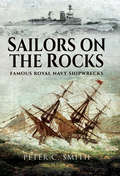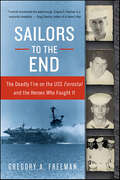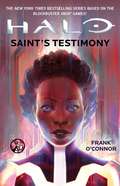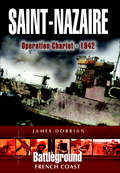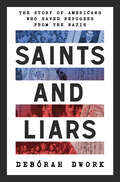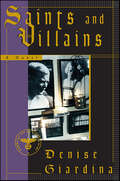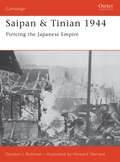- Table View
- List View
Sailor and Fiddler: Reflections of a 100-Year-Old Author
by Herman WoukIn an unprecedented literary accomplishment, Herman Wouk, one of America's most beloved and enduring authors, reflects on his life and times from the remarkable vantage point of 100 years old.Many years ago, the great British philosopher Sir Isaiah Berlin urged Herman Wouk to write his autobiography. Wouk responded, "Why me? I'm nobody." Berlin answered, "No, no. You've traveled. You've known many people. You have interesting ideas. It would do a lot of good." Now, in the same year he has celebrated his hundredth birthday, Herman Wouk finally reflects on the life experiences that inspired his most beloved novels. Among those experiences are his days writing for comedian Fred Allen's radio show, one of the most popular shows in the history of the medium; enlisting in the US Navy during World War II; falling in love with Betty Sarah Brown, the woman who would become his wife (and literary agent) for sixty-six years; writing his Pulitzer Prize-winning novel, The Caine Mutiny; as well as a big hit Broadway play The Caine Mutiny Court Martial; and the surprising inspirations and people behind such masterpieces as The Winds of War, War and Remembrance, Marjorie Morningstar, and Youngblood Hawke. Written with the wisdom of a man who has lived through two centuries and the wit of someone who began his career as professional comedy writer, the first part of Wouk's memoir ("Sailor") refers to his Navy experience and writing career, the second ("Fiddler") to what he's learned from living a life of faith. Ultimately, Sailor and Fiddler is an unprecedented reflection from a vantage point few people have lived to experience.
Sailor in the Air: The Memoirs of the World's First Carrier Pilot
by Richard Bell DaviesRichard Bell Davies was one of the most important characters in the history of naval aviation. Despite a traditional naval education - he was among the last cadets to be trained under sail - he was quick to grasp the potential of aircraft, and backed his vision by privately learning to fly. This allowed him to join the Naval Air Wing in 1913 and he enjoyed a very active, but hair-raising career during the Great War, including winning the VC for a daring rescue of a fellow pilot while under heavy fire. Because of his unique breadth of experience he was transferred to experimental work, where he played a major part in crucial developments like arrestor gear, deck barriers and the 'island' superstructure that define the modern aircraft carrier. As the first man to regularly land and take off from such ships, he did much to prove the value of shipboard aviation. After the war, in an Admiralty post, he continued to promote the flying interests of the Navy, and the book provides a first-hand chronicle of the struggles with the Air Ministry over policy and control. Although he retired in 1941, he accepted a lower rank to command one of the newly invented escort carriers, so his service ended as it had begun, at the cutting edge of naval aviation. This wonderfully active, and hugely significant career is related with a charm, modesty and humour which make the book enthralling and memorable.
Sailor in the Desert: The Adventures of Philip Gunn, DSM, RN in the Mesopotamia Campaign, 1915
by David GunnSailor in the Desert is the personal account of a Royal Navy sailor's experiences during the Mesopotamian campaign of 1915. As an able seaman on an armed sloop supporting the British expedition up the River Tigris, Philip Gunn's recollections give a rare perspective of this ill-fated campaign.At the outbreak of war, Phillip Gunn was serving on HMS Clio, a naval sloop fitted with sails and guns stationed in China and immediately tasked with hunting the soon-to-be-famous German cruiser Emden, but failed to prevent her escape. Gunn and Clio were next in action defending the Suez Canal against an attempted Turkish invasion before joining the expedition to invade Turkish-held Mesopotamia (Iraq). When the River Tigris became too shallow for Clio, Gunn took over a Calcutta River Police launch. He towed improvised gunboats to bombard the enemy in close support of the advancing land forces, whose assaults on enemy positions he witnessed. Though he repeatedly came under fire, it was malaria which finally struck him down during the pivotal Battle of Ctesiphon. He was fortunate to survive the journey back downriver. Sailor in the Desert is an authentic account drawn from Phillip Gunn's unpublished memoirs as well as conversations with the author, his son David. It is illustrated with archive photographs and colour paintings by Philip Gunn himself.As featured in the Cotswold Journal and Aberdeen Press & Journal.
Sailor in the White House
by William M. RigdonSailor in the White House, first published in 1962 as White House Sailor, is author William Rigdon’s fascinating account of his 11 years of personal service to Presidents Roosevelt, Truman and Eisenhower. As Rigdon states “with two of the three Presidents under whom I served, I was to make at least forty trips away from Washington working as their secretary, mess officer, mailman, baggageman, banker, storekeeper, photographer, custodian of secret files, and keeper of official logs. I went with Roosevelt to Cairo, Teheran, Great Bitter Lake, Yalta, both Quebec conferences, Honolulu, and the Aleutians. I was with him, too, on his inspection and political trips within the United States, on his mysterious fishing vacation to Georgian Bay in Canada, at Bernard Baruch’s place in South Carolina where the President went to recuperate after Teheran. And there were many weekends at Hyde Park and trips to Shangri-La, the President’s mountain hideaway in the Maryland mountains. On these and other occasions I saw close-up such famous figures as Prime Minister Churchill, Generalissimo Stalin, King Ibn Saud of Saudi Arabia, Emperor Haile Selassie of Ethiopia, Prime Minister Jan Christian Smuts of South Africa, Generalissimo Chiang Kai-shek, Generals Eisenhower and MacArthur, and many others. Also, on these trips away from Washington I served Harry Hopkins as secretary, when my duties with the President allowed.When President Truman took over I served him exactly as I had served President Roosevelt, going in his party to the Berlin Conference, where he met with Generalissimo Stalin, Prime Minister Churchill, and his successor Prime Minister Clement Attlee. I was with him en route home when he received King George VI in the cruiser Augusta, and in mid-Atlantic when he announced the dropping of the atomic bomb on Hiroshima.” Included are 8 pages of photographs.
Sailor' Malan—Freedom Fighter: The Inspirational Story of a Spitfire Ace
by Dilip Sarkar MBEAdolph Gysbert Malan was born in Wellington, South Africa. A natural leader and driven individual with a totally positive outlook, aged fourteen Malan became an officer cadet in the South African Merchant Navy, before being commissioned into the Royal Navy Reserve. Well-travelled and worldly-wise, aged twenty-five the intrepid adventurer applied for a Short Service Commission in the RAF. Universally known as ‘Sailor’ in the RAF, Malan became a fighter pilot. Shortly after war was declared, Malan was involved in the infamous ‘Battle of Barking Creek’, in which 74 Squadron mistakenly destroyed friendly Hurricanes. Then, over Dunkirk in May 1940, Malan’s exceptional ability was immediately demonstrated in combat and a string of confirmed aerial victories rapidly accumulated. The following month, Malan scored the Spitfire’s first nocturnal kill. By August 1940 he was commanding 74 Squadron, which he led with great distinction during the Battle of Britain. In March 1941, Malan was promoted and became the first Wing Commander (Flying) at Biggin Hill, leading the three-squadron-strong Spitfire wing during operations over northern France. After a break from operations, Malan went on to command a succession of fighter training units, passing on his tactical genius and experience, and producing his famous ‘Ten Rules of Air Fighting’ which are still cited today. By the war’s end, Group Captain Malan was the RAF’s tenth top-scoring fighter pilot. Leaving the RAF in 1945 and returning to South Africa, he was disgusted by Apartheid and founded the ‘Torch Commando’ of ex-servicemen against this appalling racist policy. This part of Malan’s life is equally as inspirational, in fact, as his wartime service, and actually tells us more about the man than just his RAF record. Tragically, in 1963, he died, prematurely, aged just fifty-three, of Parkinson’s. Written with the support of the Malan family, this biography is the full story of a remarkable airman and politician.
Sailor: Battle of Britain Legend: Adolph Malan (Images Of War Bks.)
by Philip KaplanI do not think that Malan could join a squadron without improving it, however good it was. Not by sword waving, but by a strength of mind and integrity that are at once recognizable and effective...he was the best pilot of the War' – Air Commodore Al Deere, C.B.E., D.S.O., D.F.C.Malan was thirty years of age during the Battle of Britain, old for a fighter pilot, but his maturity gave his leadership a firm authority. The Battle of Britain produced many airmen of great skill and accomplishment; high achievers who made their mark in one of history's most memorable and demanding campaigns. But only a few of these men distinguished themselves in such a way as to become legends in their own lifetimes. Among the greatest of these was Sailor Malan. Here is the story of this talented man, eloquently told by Philip Kaplan who manages to strike a balance between objectivity and reverence in order to commit Malan's story to paper. Featured too are a series of evocative black and white illustrations which supplement the descriptive text and work to create a real sense of the character of the man, flourishing as he did in this dramatic wartime context. As Malan continues to inspire young Aviators, this record looks set to preserve his legacy for a new generation of pilots as well as hardy Aviation enthusiasts.
Sailors Behind the Medals: Waging War at Sea, 1939–1945
by Chris BilhamTwenty-three riveting true stories of the heroic acts that earned WWII Royal Navy sailors their awards for gallantry.Includes photos. The story of the Royal Navy in the Second World War is an epic, consisting of both dramatic battles such as the River Plate and Matapan, and drawn-out campaigns such as the escort of convoys to Malta and northern Russia. Sailors Behind the Medals examines the careers of twenty-three sailors whose part in these actions resulted in the award of their medals. The author illustrates a cross-section of the wartime navy: long-service regulars, volunteers, recalled veterans of the Great War, Hostilities Only ratings. They served on nearly every kind of warship and in all the main theaters of the war, and their individual acts of gallantry under extreme conditions make for inspiring reading. Also included is an examination of the medals that were awarded for gallantry.
Sailors on the Rocks: Famous Royal Navy Shipwrecks
by Peter C. SmithFor three hundred years or more the Royal Navy really did Rule the Waves, in the sense that during the numerous wars with our overseas enemies, British fleets and individual ships more often than not emerged victorious from combat. One French Admiral wa
Sailors to the End: The Deadly Fire on the USS Forrestal and the Heroes Who Fought It
by Gregory A. Freeman“Riveting. . . . A compassionate account of a dramatic incident in modern naval history, told with cinematic immediacy and narrative skill.” —Kirkus ReviewsThe aircraft carrier USS Forrestal was preparing to launch attacks into North Vietnam when one of its jets accidentally fired a rocket into an aircraft occupied by pilot John McCain. A huge fire ensued, and McCain barely escaped before a 1,000-pound bomb on his plane exploded, causing a chain reaction with other bombs on surrounding planes. The crew struggled for days to extinguish the fires, but, in the end, the tragedy took the lives of 134 men. For thirty-five years, the terrible loss of life has been blamed on the sailors themselves, but this meticulously documented history shows that they were truly the victims and heroes.“[A] thorough, absorbing account.” —Library Journal
Saint's Testimony
by Frank O'ConnorAn all-new digital single--part of the New York Times bestselling series based on the blockbuster Xbox® games!The military-grade artificial intelligence known as Iona has only one week to live. After that, the UNSC will legally terminate her seven-year existence in order to stave off the threat of the data corruption phenomenon known as "rampancy," a condition that will eventually take hold of her functionality and persona, endangering all those around her. In a last-ditch effort to save herself, Iona has successfully launched an unprecedented legal appeal against her own death sentence--a case being watched very closely at not only the highest levels of human government, but by others with a very different agenda...
Saint-Nazaire: Operation Chariot – 1942 (Battleground French Coast)
by James DorrianIn early 1942, shipping losses in the Atlantic threatened Britain's very survival. In addition to the U-Boat menace, there was real concern that the mighty German battleship Tirpitz be unleashed against the vital Allied convoys. Yet only the 'Normandie' Dock at St Nazaire could take her vast size in the event of repairs being required. Destroy that and the Tirpitz would be neutralized.Thus was born Operation CHARIOT, the daring Commando raid that, while ultimately successful, proved hugely costly. Using personal accounts, James Dorrian describes the background and thrilling action that resulted in the award of five Victoria Crosses.In a dramatic final twist of events, once the battle was over, the converted former US warship Campelton blew up wrecking the dock gates and killing many Germans who thought the battle was won.
Saints and Liars: The Story of Americans Who Saved Refugees from the Nazis
by Debórah DworkA gripping history that plumbs the extraordinary stories of American relief and rescue workers during World War II. Long before their country officially joined the war, American aid workers were active in rescue efforts across Europe. Two such Americans were Martha and Waitstill Sharp, who were originally sent to Prague as part of a relief effort but turned immediately to helping Jews and dissidents after the 1939 invasion by Germany. They were not the only ones. Renowned historian Debórah Dwork follows the story of rescue workers in five major cities as the refugee crisis expanded to Vilna, Shanghai, Marseille, and Lisbon. Followed by Nazi agents, spiriting people across borders, they learned secrecy. Others negotiated with government representatives, like Laura Margolis, who worked with the Japanese, to get enough food and warm shelter for the refugees in Shanghai. Yet, the women also often faced lack of support from their agencies; if part of a couple, they fought to get paid even at a low salary despite working as long and hard as their husbands. Moving and revelatory, Saints and Liars illuminates the unpredictable circumstances and often fast-changing historical events with which these aid workers contended, while revealing the moral questions they encountered and the devastating decisions they had to make. Drawing on a multitude of archival documents, from letters to diaries and memos, Dwork offers us a rare glimpse into the lives of individuals who—at times with their organizations’ backing, but sometimes against their directives—sought to help people find safe haven from persecution.
Saints and Villains: A Novel
by Denise GiardinaAn astonishing historical novel in the tradition of Schindler's List--evoking powerfully the danger and heroism of the Nazi resistance. What is the price of acting morally in a time of great evil, when sin and necessity seem twinned? Saints and Villains is a strikingly resonant novel that dramatizes this painful dilemma through the fictional re-creation of the life of Dietrich Bonhoeffer. This emblematic figure risked his life--and finally lost it--through his participation in the failed plot to assassinate Hitler and topple the Nazi regime. In a gripping and sweeping narrative that moves from Berlin to London to New York City, encompassing shattering historical events, clandestine meetings, perilous missions abroad, and eventual imprisonments and death, Denise Giardina brings to life an instance of shining courage in the charnel house that was Europe in the Second World War. A novel that is bold in conception and utterly convincing in its powers of fictional re-creation--a literary event.
Saipan & Tinian 1944
by Howard Gerrard Gordon RottmanThe 1944 invasion of Saipan was the first two-division amphibious assault conducted by US forces in World War II (1939-1945). Saipan and Tinian had been under Japanese control since 1914 and, heavily colonized, they were considered virtually part of the Empire. The struggle for Saipan and Tinian was characterized by the same bitter fighting that typified the entire Central Pacific campaign. Fighting side-by-side, Army and Marine units witnessed the largest tank battle of the Pacific War, massed Japanese banzai charges, and the horror of hundreds of Japanese civilians committing suicide to avoid capture. In this book Gordon Rottman details the capture of these vital islands that led to the collapse of Prime Minister Tojo's government.
Saipan: The Battle That Doomed Japan in World War II
by James H. HallasThe story of the Battle of Saipan has it all. Marines at war: on Pacific beaches, in hellish volcanic landscapes in places like Purple Heart Ridge, Death Valley, and Hell&’s Pocket, under a commander known as &“Howlin&’ Mad.&” Naval combat: carriers battling carriers from afar, fighters downing Japanese aircraft, submarines sinking carriers. Marine-army rivalry. Fanatical Japanese defense and resistance. A turning point of the Pacific War. James Hallas reconstructs the full panorama of Saipan in a way that no recent chronicler of the battle has done. In its comprehensiveness, attention to detail, scope of research, and ultimate focus on the men who fought and won the battle on the beaches and at and above the sea, it rivals Richard Frank&’s modern classic Guadalcanal. This is the definitive military history of the Battle of Saipan.
Saladin
by David Nicolle Peter DennisThis Osprey Command book looks closely at the early life, military experiences and key battlefield exploits of Al-Malik al-Nasir Yusuf Ibn Najm al-Din Ayyub Ibn Shahdi Abu'l-Muzaffar Salah al-Din - or Saladin as he is more commonly known outside the Islamic world - who is broadly regarded as the greatest hero of the Crusades, even in Europe. Most chroniclers present him as a man of outstanding virtue, courage and political skill. More recently, however, efforts have been made to portray Saladin as an ambitious, ruthless and even devious politician, and as a less brilliant commander than it normally thought. This book sets out to reveal that the truth is, as usual, somewhere in between.From the Trade Paperback edition.
Saladin: Hero of Islam
by Geoffrey HindleyThis biography of the 12th century Islamic military leader provides a fascinating view of the Crusades and the Medieval Muslim world. Saladin was a Kurdish military leader who led the fight against the Crusades and rose to become first Sultan of Egypt and Syria. He united warring Muslim lands, reconquered the bulk of Crusader states and faced King Richard I of England in one of the most famous confrontations in medieval warfare. His extraordinary character and career are the key to understanding the Battle of Hattin, the fall of Jerusalem and the failure of the Third Crusade. Historian Geoffrey Hindley's study of Saladin&’s life and times presents a nuanced portrait of this remarkable man who dominated the Middle East in his day. It also offers fascinating insight into the politics and culture of the 12th century Muslim world.
Salamanca 1812
by Bill Younghusband Ian FletcherOsprey's study of Salamanca (1812), the most decisive battle of the entire Peninsular War (1808-1814). Wellington smashed Marmont's French Army and his pursuit of its shattered remnants led to the famous cavalry charge of the King's German Legion at Garcia Hernandez. There would be two more years of sieges and hard fighting before the Iron Duke crossed the Pyrenees into France but from Salamanca the British and their Portuguese and Spanish allies always had the upper hand. Ian Fletcher examines this important battle in detail and also discusses the campaign which led up to it.
Salamanca Campaign 1812 (Peninsular War Battlefield Companion)
by Tim SaundersAfter a gap of two years, the 1812 Salamanca Campaign saw Wellington taking the offensive in Spain against Marshal Marmont’s Army of Portugal. Marching from the border fortress of Ciudad Rodrigo which fell to the Allies in January, neither commander was willing to take the risk of a general action without a clear tactical advantage. The result were stand-offs as Wellington offered battle on the San Christóbal Heights, but once the small French-garrisoned forts left behind in Salamanca fell, Marmont withdrew to the Douro. For over a week the two armies shared cooling waters of the river before Marmont ‘humbugged’ Wellington and fell on the Allied left flank at Castrejón. Wellington rushed to the aid of the Light and 4th divisions with the heavy cavalry. Over the following days Marmont dexterously manoeuvred Wellington back towards Salamanca, with both armies within cannon shot still not risking battle. When it seemed Wellington would have to march back to the safety of Portugal, Marmont finally made a mistake on the plains south of Salamanca on 22 July 1812, by allowing his army to become over extended. Wellington saw what was happening and after weeks of marching and counter marching, the battle the soldiers earnestly hoped for was on. In the past it has been difficult to place the fighting on the ground in the centre of the Salamanca battlefield, where ‘vast clouds of smoke and dust that rolled along the basin’ obscured vision even for those fighting. Supplementing their letters, diaries and memoires with modern geographical aids, archaeology and a stout pair of boots, it is now possible to reconcile the sequence of the battle with locations, in a way in which it was not feasible even a few years ago.
Salamaua 1943 (Australian Army Campaigns Series)
by Phillip BradleyBetween the end of the Kokoda campaign in January 1943 and the start of the New Guinea offensives at Lae in early September 1943, the Australian Army was engaged in some of the most intense and challenging fighting of the war for the ridges around Salamaua. Following the defeat of the Japanese offensive against Wau, it was decided to carry the fight to the Japanese force at Salamaua but what started as platoon level actions in April and May 1943 soon developed into company, battalion and brigade level operations for control of the dominating ridge systems around Salamaua. Following an amphibious landing, an American infantry regiment and supporting artillery units were also drawn into the fighting in July 1943. Salamaua 1943 also includes detailed insights into the tenacious Japanese defence of Salamaua, a defence to a threat that in the end was only a feint to draw Japanese forces away from Lae. Incorporating over 120 photographs from the battlefield including drone footage plus 26 maps and the added detail of 15 sidebars, Salamaua 1943 takes the reader behind what was one of the most complex campaigns of the Pacific War.
Salerno 1943
by Steve Noon Angus KonstamIn mid-September 1943, as the opening move of the Allied campaign to liberate the mainland of Italy, an Anglo-American invasion force landed on the beaches of the Gulf of Salerno, only a few dozen miles to the south of Naples. Italy had just surrendered, and the soldiers in the landing craft prayed that the invasion would be unopposed. It was not to be. The Germans had seized control of the Italian-built beach defences, and were ready and waiting. What followed was one of the bloodiest battles of the whole Mediterranean campaign - a ten day contest where victory hung in the balance. Over 80,000 British and American soldiers waded ashore at Salerno, and after bitter fighting they managed to establish a narrow and vulnerable bridgehead. The British enclave near Salerno was separated from the American sector around Paestum by a river, and German-held strongpoints. All attempts to link up the two parts of the bridgehead were thwarted by the German defenders, who were being reinforced faster than the Allies. Then the Americans were nearly flung back into the sea by a ferocious German counterattack, as the German commander on the spot used his veteran armour and Panzergrenadiers to deadly effect. Although driven back towards the beach, the Americans rallied and grimly held on, and the crisis passed. The ferocious ten-day battle at Salerno was eventually decided by a combination of Allied reinforcements, and secondary landings in support of the beleaguered Salerno bridgehead. The battle for Salerno changed the course of the campaign - by its end it was clear that wherever possible the Germans were going to fight for every inch of ground in Italy, and the campaign was not going to be the easy victory the Allied commanders had hoped. Using documentary records, memoirs and eyewitness accounts from all sides, Angus Konstam recreates the battle day by day, hour by hour. His methodically researched account offers a fresh perspective on a decisive battle that has largely been neglected by British and American historians in recent years.
Salerno to the Gustav Line, 1943–1944: Rare Photographs From Wartime Archives (Images of War)
by Jon Diamond Dr.In September 1943, shortly after the conquest of Sicily, the Allied armies made amphibious assaults on the Italian Mainland at Calabria, Taranto and along the Gulf of Salerno beaches. The Italian Government quickly capitulated but the Germans fought on. Although the British XIII Corps and 1st Airbornes attacks were largely uncontested in Calabria and Taranto, the Allied Fifth Armys beachheads at Salerno underwent savage Nazi counterattacks.After Salerno, the Allied Fifth and Eighth Armies continued their advance north initially to the ports of Naples and Bari before struggling through Italian massifs, held up by a determined enemy and unfavorable ground and weather. In January 1944, the Fifth Armys X, II and French Expeditionary Corps attacked across the Garigliano and Rapido Rivers with the aim of breaking through the Gustav Line fortifications. The Nazi defense at the town of Cassino just succeeded in halting the two-week Allied attack during First Battle of Cassino and the Gustav Line was to be the scene of fierce fighting for months.
Salerno: 9 September - 6 October 1943
by AnonIllustrated with 18 maps and 24 IllustrationsEARLY IN SEPTEMBER 1943, British and American armies invaded southern Italy, striking at the heart of a major Axis nation and breaching Hitler's "Fortress Europe." Behind the invasion lay long months of hard-won Allied victories. The Axis was cleared out of Africa in May, when British and American armies annihilated the German and Italian forces cornered in Tunisia. Sicily, the stepping stone from Africa to Europe, was next conquered in a 38-day battle, and on 17 August the last of its German garrison fled across the Strait of Messina to the Italian mainland. On 3 September the British Eighth Army crossed the Strait in pursuit and drove up the Calabrian Peninsula. Coordinated with the Eighth Army's attack, Allied landings at Salerno by the United States Fifth Army and at Taranto by the British 1 Airborne Division were made on 9 September. In the Salerno landings, strong American forces were fighting on the continent of Europe for the first time since 1918.Even before the beginnings of the Sicilian operations, the staffs of Allied land, naval, and air forces had been planning an invasion of Italy. Once established on the Italian mainland, we might hope to secure complete naval and aerial domination of the Mediterranean and to obtain strategic ports and airfields for future operations against continental Europe. If we could knock Italy out of the war, we would force the Germans to retreat north of the Alps or to use in Italy armies which might be fighting on the Russian front.Under the command of Lt. Gen. Mark W. Clark, the Fifth Army, a great Allied force composed of the British 10 Corps and the United States VI Corps, carried out the first large scale invasion of the European mainland and secured a firm base for future operations in Italy. Salerno: The American Operations from the Beaches to the Volturno is an account of the American forces who landed on the beaches in the Gulf of Salerno.
Salient Points Five: Ypres & Picardy, 1914–18 (Cameos of the Western Front #5)
by Ted Smith Tony SpagnolyAs with previous books in the series, 'Salient Points 5' features a number of stories of the individuals and units taking part in these Great War actions. Included in this edition are the London Irish at Hollebeke, the 2nd Grenadier Guards at Klien-Zillebeke, the birth of the notorious Birdcage at Polegsteert, the fate of 2nd/Lt. Paul J Rodocanachi R F C at Torreken Farm, Poet Roland Leightons death near Gommecourt Wood, the 10th, 11th and 13th Cheshires at St Yves and Le Gheer, the 7th Inniskillings Fusiliers at Wytschaete, the London Rifle Brigade at Ploegsteert and the 2nd Royal Welch at Loos. Also included are two stories covering recent events concerning the military burials of the remains of two Lancashire Fusiliers at Prowse Point Military Cemetery and a reflective wander around the Ypres Town Cemetery and Extension. All bring to the Great War enthusiast a more personalized view of the men, the events in which they took part and the areas where they were involved.
Salient Points Four: Ypres & Picardy, 1914–18 (Cameos of the Western Front #4)
by Ted Smith Tony SpagnolyConcentrating on the Ploegsteert and Neuve Eglise sectors in Belgium, this book features stories on such well known figures as sculptor Charles Sargent Jagger, ARA ; R Poulton Palmer and 'Tanky' Turner, great friends and rugby football captains of England and Scotland respectively; as well the discovery and eventual burial of a Lancashire Fuslier who was killed in action in 1914; the research leading to the erection in 2002 of a 'Believed to be buried' headstone in the Strand cemetery of an Australian killed in action at Messines in 1917; the action in 1914 that initiated the birth of the infamous 'Birdcage' on the western edge of Ploegsteert Wood and other stories of interest to enthusiasts of the Great War.Another in the Cameos of the Western Front series on men, minor actions and battlefield sites, this book, like its predecessors is an ideal 'companion' for the battlefield visitor.
